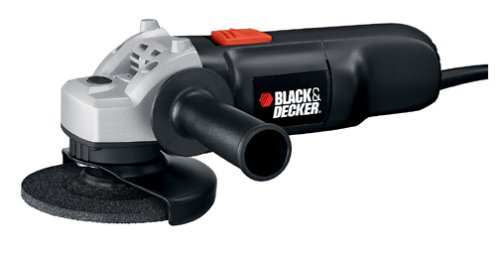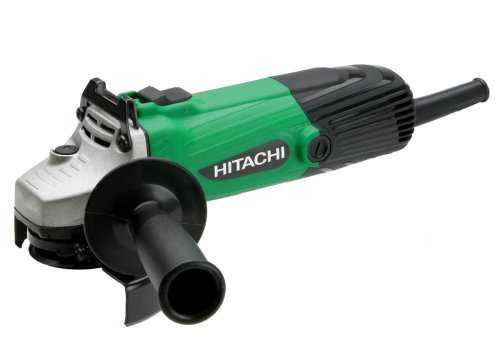A Bandsaw give you freedom to design and build anything you want. If you want 5/8" drawer sides, you should have them. Resawing on the Bandsaw gives you the ability to cut stock thickness quickly, safely, and efficiently.
Resawing allows you to control the thickness of wood. After resawing and one or two passes through a thickness planer, you are free from the yoke of standard thickness. Are you content with only 3/4" wood for everything you build?
4 1 2 Angle Grinder
Resawing is nothing more than taking a piece of wood and cutting it into thinner pieces. The bandsaw is the ideal tool for this job. It is far safer than a tablesaw.
Its narrow kerf and vertical blade movement make it extremely efficient. It wastes minimal wood. Cutting is easy and quick. All you do - cut straight lines. A board with one square edge and side is necessary.
Problem is, most woodworkers don't have a clue how to do this. Successful resawing calls for nothing more complicated than appropriate blade selection, adequate tension, setting the fence, and proper stock control.
Blade Selection: As you saw through very thick stock, you put a lot of pressure on every part of the blade engaged in the cut. Each saw tooth shaves out waste. Blades with 3 teeth per inch (tpi) have large gullets which have room for a lot of waste.
Thrust bearings support the blade above and below. During the actual cut, only the blade's stiffness or "beam strength" will keep the cut proceeding straight and free of wander. It's my experience that a quality 1/2" 3-tooth blade gives good results. I tried wider blades with no increase in efficiency.
Tension: Adequate blade tension reduces the blade's tendency to lead erratically under thrust. I have found that the standard tension gauge is not accurate. It is better to use a little more tension than indicated.
You can check it by opening up the thrust bearings and lateral guides. Back off both above and below the table so they do not contact the blade. Crank the tension gauge to the desired setting. Give the blade a sideways nudge about halfway between the upper and lower wheels. The blade will deflect easily for a short distance. This sideways movement should be 1/4". If you push harder, it will bend farther but there is a distinct point where it quits deflecting easily. If you can deflect more than 1/4", then add tension until this deflection is 1/4".
Stock Control: How does one cut straight lines? Answer: find out how the saw wants to do it, and do it that way.
Every good bandsaw blade can cut straight lines. Each blade will do so in its own way. In other words, each blade has its own "lead angle". How can we determine this lead angle?
Some experts suggest using a Resaw Guide. This is like a single point, which allows you to change the angle of your feed into the blade. It takes practice to use this method. Moreover, this technique requires constant attention.
If you have to figure out the right feed direction, why not just do it once? Then set your bandsaw fence accordingly, and cut straight lines. It is just that easy.
Ensure that the blade and fence are both 90-degrees to your table. Take a straight piece of wood about two to three feet long. Mark a line down the center. Cut freehand along the line, trying to keep the cut on the centerline. Feed at a normal pace. Once you have it straight, hold your piece of wood to the table. Turn off the bandsaw. You have found the lead angle for this blade!
With a pencil, mark a line on the bandsaw table along the piece of wood. Loosen the fence's bolts with a wrench. Set the angle of the fence along the pencil line of the test cut. Tighten your bolts. Your fence is now set for the blade's correct lead angle. This gives you straight cuts. Set once and cut. What could be simpler?
You may want to practice your feed speed. It is a good idea to mark a line on your intended cut for the first several boards. It just gives you faith that the cut is straight.
You will gain confidence with this method. It gives you more versatility with your projects. With a little practice, you can't go wrong. Have fun while resawing with safety in mind!












 Super Joint System (SJS) is an innovation from Makita engineering where the motor armature and spiral bevel gear are linked by a coil spring. If the grinding wheel catches or binds, the coil spring relaxes and disengages the gears from the motor. As the grinding wheel stops, the gears and motor are protected. Makita's growing line of SJS-equipped grinders includes models ranging from a 1/4" die grinder to a 7-inch angle grinder.
Super Joint System (SJS) is an innovation from Makita engineering where the motor armature and spiral bevel gear are linked by a coil spring. If the grinding wheel catches or binds, the coil spring relaxes and disengages the gears from the motor. As the grinding wheel stops, the gears and motor are protected. Makita's growing line of SJS-equipped grinders includes models ranging from a 1/4" die grinder to a 7-inch angle grinder. About Makita
About Makita










